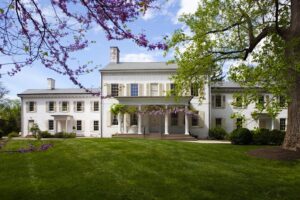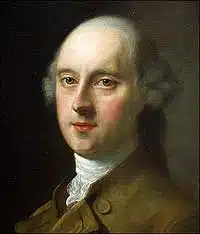Between his education and his friendship with influential and intellectual people, Richard Stockton brought an extraordinary amount of energy to the New Jersey delegation that signed the Declaration of Independence. He was also the first of the 56 delegates who signed the Declaration, and the only Signer to be imprisoned for his actions.
Stockton, the son of John Stockton who was the founder of the College of New Jersey, now known as Princeton University, was a longtime friend of George Washington.
It was through Washington that the New Jersey native met Benjamin Rush. And it was through Rush that Stockton met John Witherspoon and secured his position as President of the College of New Jersey.
Like Stockton, Witherspoon was one of the five New Jerseyans who signed the Declaration of Independence as members of the Second Continental Congress.
Stockton was born in Princeton in 1730 and attended West Nottingham Academy, a private school in Maryland started by a Presbyterian minister who also later became a President of the College of New Jersey. Stockton studied law and was admitted to the bar at age 24, rapidly gaining a reputation for his prudence and wisdom.
For several years, he traveled extensively in England, was welcomed by royalty, and highly respected for his values and intelligence.
Stockton was married to Annis Boudinot, one of the most renowned female poets of the era and the couple had two sons and four daughters.
Returning to the colonies from England, Stockton remained respected and the most acclaimed attorney in the colony.
While he had no use for politics and displayed an open distrust of the public, Stockton was a member of Congress where he preferred to take the middle road, opposing both extreme points of view in most areas, including freedom from England through revolution.
It was the Stamp Act of 1765 under which George III imposed a stiff tariff on all the colonies in the New World that convinced Stockton of the importance and need for independence; still, he worried about how to pay for the war, raise and support an army and start a new government.
In the hopes of a peaceful agreement between England and the colonies, he drafted a plan giving independence for the colonies without renouncing the British Crown. When that plan was rejected by the King in 1774, Stockton than favored independence by whatever means necessary.
In the early years of the Revolution Stockton turned down his election as Chief Justice of the state Supreme Court, preferring to stay a member of Congress to further the fight for liberty.
After signing the Declaration, Stockton was appointed to committees supporting the war effort. He was sent on a fact-finding tour throughout the colony, and returned to Morven at the same time as the British were ravaging New Jersey.
Although he managed to get his family to safety, the Signer was captured and imprisoned by the British, first in Perth Amboy later in Provost Prison in New York. At that prison, he was intentionally starved, subjected to freezing weather, and beaten and abused for five weeks because of his signature on the Declaration.
After nearly five weeks of abusive treatment, Stockton was released on parole, his health battered. His release was secured through the efforts of his old friend George Washington but required him to sign an agreement with England he would not contribute any efforts towards the War.

Stockton returned to his estate, Morven, in Princeton, regaining the property though all his household belongings, including a massive library, crops and livestock were taken or destroyed by the British.
The estate remained in the Stockton family until the 1944 when it was sold to New Jersey Governor Walter Edge with the provision it be turned over to the state within two years of his death. Edge turned the estate over to New Jersey in 1954 two years before he died.
Stockton retired from Congress. took months to regain a modicum of health, then reopened his law practice and taught new students. However, he developed a cancer on his lip which then spread to his throat, and Stockton died Feb. 28, 1781, at 50 years old.
The New Jersey Signer of the Declaration of Independence is buried at Stony Brook Meeting House, a historic Quaker site located at 470 Quaker Road, Princeton.





